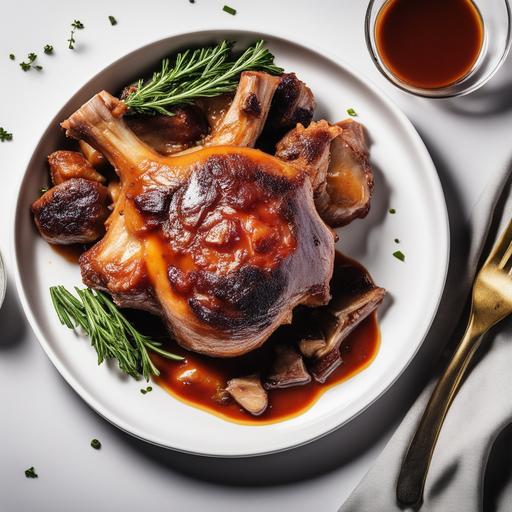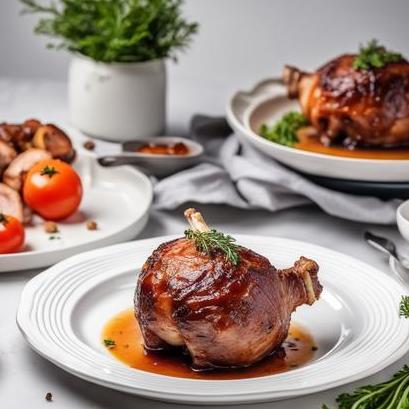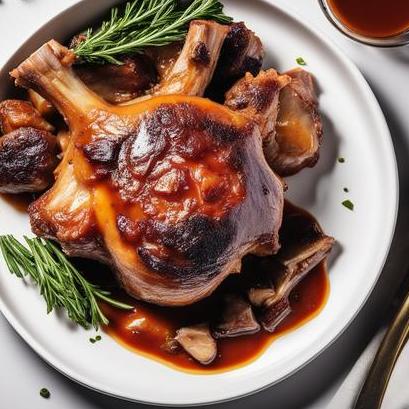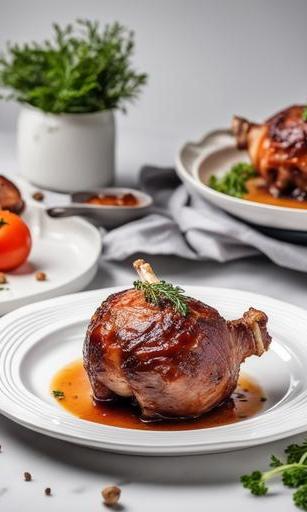[GUIDE] How Long To Cook Pork Shank In Oven

Cooking pork shank in the oven can result in a flavorful and tender dish that is perfect for special occasions or cozy family meals. Pork shank is a tougher cut of meat that comes from the lower leg of the pig. It is rich in collagen, which makes it perfect for slow-cooking methods that help break down the tough connective tissues and create a melt-in-your-mouth texture. In this article, we will explore the ideal cooking time and temperature for pork shank in the oven, different cooking techniques, troubleshooting tips, and more.
Quick Answer: How Long To Cook Pork Shank In Oven
The cooking time for pork shank in the oven depends on various factors such as the size of the shank, the oven temperature, and the desired level of tenderness. As a general guideline, pork shank should be cooked in a preheated oven at 325°F (163°C). Plan on cooking the shank for 2.5 to 3 hours for a 2- to 3-pound shank. However, it’s crucial to remember that these are just approximate times. Cooking pork shank is a process that requires some flexibility, as each shank may have different levels of toughness.
Key Takeaways
- Pork shank is a tough cut of meat, ideal for slow cooking methods like oven roasting.
- Preheating the oven to 325°F (163°C) is generally recommended for cooking pork shank.
- Cook pork shank for about 2.5 to 3 hours for a 2- to 3-pound shank.
- The internal temperature should reach 195°F (90°C) for tender meat.
- Basting and adding liquids to the roasting pan can help prevent drying out.
The Science Of Cooking Pork Shank

Understanding the science behind cooking pork shank can help achieve the best possible results. Pork shank is a muscle that gets a lot of exercise, making it tough and chewy. However, with the right cooking techniques, the tough tissues in the shank can be broken down, resulting in a tender and flavorful dish.
The primary component in the connective tissues of meat is collagen. When collagen is subjected to low and slow cooking methods, it undergoes hydrolysis. Hydrolysis breaks down the collagen into gelatin, which contributes to a tender and juicy texture in the pork shank. This is why slow cooking methods like oven roasting are ideal for transforming tough cuts like pork shank into a delicious and succulent dish.
Choosing Pork Shank
When selecting pork shank, look for fresh cuts that have a pinkish-red color. The meat should be well-marbled with fat, as this will contribute to flavor and tenderness during the cooking process. Avoid shanks that have a grayish color or a strong, unpleasant smell, as these may indicate spoilage.
It’s also important to consider the size of the pork shank. Larger shanks will require more cooking time to break down the tough connective tissues. The weight of the shank will give you an idea of the approximate cooking time.
Preparing Pork Shank

Before cooking the pork shank, there are a few essential preparation steps to follow:
-
Pat dry the shank: Use paper towels to remove any excess moisture from the surface of the pork shank. This will help the seasoning adhere to the meat better and promote browning during cooking.
-
Season the shank: Generously season the pork shank with salt and pepper, or any other desired seasonings. You can also add herbs and spices like rosemary, thyme, garlic powder, or paprika to enhance the flavor.
-
Let the shank rest: Allow the seasoned pork shank to rest at room temperature for about 30 minutes before cooking. This step helps the meat cook more evenly and ensures juiciness.
Ideal Cooking Temperature For Pork Shank
For cooking pork shank in the oven, a moderate temperature is recommended to allow for slow and controlled cooking. Preheat your oven to 325°F (163°C). This temperature is high enough to render the fat and break down the collagen, but not so high that it dries out the meat.
Pork Shank Cooking Time

The cooking time for pork shank can vary depending on factors such as the size of the shank, oven temperature, and desired level of tenderness. As a general rule of thumb, plan on cooking a 2- to 3-pound pork shank for 2.5 to 3 hours at 325°F (163°C).
It’s important to note that these times are just guidelines, and cooking pork shank is not an exact science. The actual cooking time may vary based on the toughness of the shank. To ensure tenderness, the internal temperature of the pork shank should reach at least 195°F (90°C). This will help break down the collagen further and result in a tender and flavorful dish.
Cooking Techniques
There are a few cooking techniques that can be employed to enhance the flavor and texture of pork shank when cooking it in the oven:
-
Oven Roasting: This is the most common cooking method for pork shank. It involves slow-cooking the shank at a low temperature for an extended period, allowing the connective tissues to break down gradually. The shank is placed on a roasting rack or a bed of aromatic vegetables, then cooked until tender.
-
Braising: Braising involves first searing the pork shank in a hot pan to develop a crust and enhance the flavor. Then, the shank is placed in a covered dish with liquid such as broth, wine, or a combination of both. The dish is then baked in the oven at a low temperature until the shank is cooked and tender.
-
Sous Vide: This method involves vacuum-sealing the pork shank along with desired seasonings and cooking it in a water bath at a controlled temperature for an extended period. Sous vide ensures precise temperature control and results in a consistently tender and juicy shank.
Using any of these techniques can yield a delicious and tender pork shank, so choose the method that best suits your cooking style and available equipment.
Pro Tip: When braising pork shank, using a flavorful liquid such as beef or vegetable broth, red wine, or a combination of both can enhance the taste of the dish. Vegetables like carrots, onions, and celery can also be added to the braising liquid for extra flavor.
Monitoring And Troubleshooting

While cooking pork shank in the oven, it’s important to monitor the progress to achieve the desired level of tenderness. Here are a few tips to help you along the way:
- Basting: Every 30 minutes or so, baste the pork shank with the juices and fats in the roasting pan. This helps prevent the meat from drying out and enhances the flavors.
- Adding liquids: If you notice that the pork shank is drying out during cooking, add a small amount of liquid (such as broth or wine) to the roasting pan. This will help keep the meat moist and tender.
- Checking the internal temperature: Use a meat thermometer to check the internal temperature of the pork shank. Insert the thermometer into the thickest part of the meat, avoiding contact with the bone. The internal temperature should reach at least 195°F (90°C) for tender meat.
- Testing for tenderness: If the cooking time has passed, but the pork shank is not as tender as desired, continue cooking until the meat easily pulls away from the bone with a fork. This indicates that the collagen has fully broken down, resulting in a tender texture.
Pork Shank Cooking Instructions
Here is a step-by-step guide on how to cook pork shank in the oven:
- Preheat your oven to 325°F (163°C).
- Pat dry the pork shank with paper towels.
- Season the shank with salt, pepper, and any desired herbs or spices.
- Let the shank rest at room temperature for about 30 minutes.
- Place the pork shank on a roasting rack or a bed of vegetables in a roasting pan.
- Insert a meat thermometer into the thickest part of the shank, avoiding contact with the bone.
- Roast the pork shank in the preheated oven for 2.5 to 3 hours, or until the internal temperature reaches at least 195°F (90°C).
- Baste the shank with the juices in the pan every 30 minutes to prevent drying.
- If needed, add a small amount of liquid (broth or wine) to the roasting pan to keep the meat moist.
- Once the pork shank is cooked and tender, remove it from the oven and let it rest for about 10 minutes before slicing or serving.
Variations

While the classic oven-roasted pork shank is delicious on its own, there are several variations that you can try to add a twist to the dish:
- Flavored Rubs: Experiment with different rubs and seasonings to add more complexity to the flavors. For example, you can try a mix of paprika, cumin, garlic powder, and brown sugar for a smoky and slightly sweet flavor.
- Glazes: Toward the end of cooking, you can brush the pork shank with a glaze made from ingredients like honey, maple syrup, soy sauce, or balsamic vinegar to add a shiny and flavorful coating.
- Sauces: Serve the cooked pork shank with a delicious sauce, such as a tangy barbecue sauce, a rich demi-glace, or a creamy mushroom sauce. These sauces can further complement the flavors of the tender meat.
Feel free to experiment with different flavors and ingredients to create a pork shank dish that suits your taste preferences.
When Things Go Wrong
While cooking pork shank in the oven, there are a few common issues that can arise. Here are some troubleshooting tips for when things don’t go as planned:
- Pork Shank Not Tender: If the cooking time has passed, but the meat is not as tender as desired, continue cooking for an additional 15-30 minutes. Check the tenderness regularly until the meat easily pulls away from the bone.
- Dry Meat: If the pork shank is turning out dry, it may have cooked for too long or at too high of a temperature. To prevent dryness, make sure to baste regularly and add liquid to the roasting pan as needed.
- Uneven Cooking: If the pork shank is cooking unevenly, rotate the pan halfway through the cooking process. This helps ensure that the shank cooks evenly on all sides.
Remember that cooking pork shank is a learning process, and it may take a few attempts to achieve the perfect results. Take note of any adjustments you made and consider trying a slightly different approach next time.
Serving Pork Shank

Once the pork shank is cooked to perfection, it’s time to enjoy the flavorful and tender meat. Here are a few serving suggestions:
- Slice the pork shank: Use a sharp knife to slice the pork shank into thick slices. Arrange the slices on a serving platter.
- Sauce or glaze: Drizzle the pork shank with any sauces or glazes that were prepared during the cooking process.
- Aromatic vegetables: Serve the pork shank on a bed of roasted vegetables such as carrots, potatoes, or Brussels sprouts. The roasted vegetables will complement the flavors of the meat.
- Sides: Accompany the pork shank with a side dish like mashed potatoes, creamy polenta, or a fresh garden salad.
Best Practices For Pork Shank Cooking
To ensure a successful and delicious outcome, here are some best practices to keep in mind when cooking pork shank in the oven:
- Choose a fresh and well-marbled pork shank for optimal flavor and tenderness.
- Preheat the oven to 325°F (163°C) before cooking the shank.
- Pat dry the shank and season it generously to enhance the flavors.
- Allow the seasoned shank to rest at room temperature to ensure even cooking.
- Use a meat thermometer to monitor the internal temperature and ensure tenderness.
- Baste the shank regularly and add liquid to the roasting pan as needed to prevent drying.
- If necessary, continue cooking until the meat easily pulls away from the bone with a fork for maximum tenderness.
- Experiment with different seasonings, rubs, glazes, and sauces to customize the dish to your liking.
Conclusion
Cooking pork shank in the oven is a process that requires patience, but the end result is worth the wait. With slow and controlled cooking, you can transform a tough cut of meat into a tender and flavorful masterpiece. By following the recommended cooking time and temperature, monitoring the internal temperature, and employing different cooking techniques, you can achieve a melt-in-your-mouth texture that will impress your family and guests. So take your time, savor the process, and enjoy the delicious pork shank dish that awaits you!
FAQS
How Long Should I Cook Pork Shank In The Oven?
The recommended time to cook pork shank in the oven is about 2 to 3 hours. However, the exact cooking time largely depends on the size and thickness of the pork shank. You need to ensure that the internal temperature of the pork shank reaches between 145 and 160°F.
What Temperature Should The Oven Be Set To Cook Pork Shank?
To cook pork shank in the oven, you need to preheat it to 350°F. This temperature is sufficient to cook the pork shank thoroughly without burning it. You can cover the pork shank with foil during the first hour of baking to keep it moist, before removing the foil for the remaining time.
How Can I Determine If The Pork Shank Is Cooked Thoroughly?
To verify if the pork shank is cooked thoroughly, use a meat thermometer to check the internal temperature. Insert the meat thermometer into the thickest part of the pork shank, avoiding the bone. When the temperature measures between 145 and 160°F, the pork shank is cooked and ready to eat.
Can I Speed Up The Cooking Time When Cooking Pork Shank In The Oven?
Although it is not advisable to rush the cooking process when cooking pork shank, you can slightly lower the cooking temperature to about 325°F to speed up the cooking time slightly. This should still be done with care because overcooked pork can become dry and tough.
Should I Marinate The Pork Shank Before Cooking It In The Oven?
You can marinate the pork shank before cooking it in the oven to enhance the flavor. A good marinade should include acid, such as lemon juice or vinegar, and oil, herbs, and spices. The marinade should be applied to the pork shank at least a few hours before cooking to infuse the flavors well.
Sources
About the Author Jenny
I'm Jenny, a housewife with an unwavering passion for food. My culinary journey began with my grandmother's kitchen, and it's now a full-fledged food blog. I've turned my love for cooking into a creative outlet, sharing recipes and stories with a global community of fellow food enthusiasts. It's proof that being a housewife can also mean pursuing your passions and savoring life's delectable moments.
